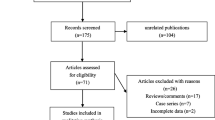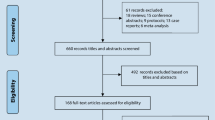Abstract
Many studies have investigated the association between glutathione S-transferase T1 (GSTT1) null genotype and risk of coronary heart disease (CHD), but the impact of GSTT1 null genotype on CHD is still unclear owing to the obvious inconsistence among those studies. This study aims to quantify the strength of association between GSTT1 null genotype and risk of CHD. We searched the PubMed, Embase and Wangfang databases for studies relating the association between GSTT1 null genotype and risk of CHD. We estimated summary odds ratio (OR) with their 95 % confidence interval (95 % CI) to assess the association. 24 case–control studies with 13, 884 CHD cases and 30, 719 controls were included into this meta-analysis. Meta-analysis of total 24 studies showed GSTT1 null genotype was not associated risk of CHD (random-effects OR = 1.17, 95 % CI 0.97–1.42, P = 0.101). After adjustment for heterogeneity, meta-analysis showed GSTT1 null genotype was associated increased risk of CHD both in total population and Caucasians (for total population, fixed-effects OR = 1.12, 95 % CI 1.05–1.21, P = 0.001; for Caucasians, fixed-effects OR = 1.10, 95 % CI 1.02–1.19, P = 0.010). There was no significant association in the other populations. No evidence of publication bias was observed. Meta-analyses of available data suggest the GSTT1 null genotype contributes to increased risk of CHD in Caucasians.




Similar content being viewed by others

References
Epstein FH, Fuster V, Badimon L et al (1992) The pathogenesis of coronary artery disease and the acute coronary syndromes. N Engl J Med 326:242–250
White HD, Chew DP (2008) Acute myocardial infarction. Lancet 372:570–584
Pfisterer ME, Zellweger MJ, Gersh BJ (2010) Management of stable coronary artery disease. Lancet 375:763–772
Hansson GK (2005) Inflammation, atherosclerosis, and coronary artery disease. N Engl J Med 352:1685–1695
Libby P, Theroux P (2005) Pathophysiology of coronary artery disease. Circulation 111:3481–3488
Samani NJ, Erdmann J, Hall AS et al (2007) Genomewide association analysis of coronary artery disease. N Engl J Med 357:443–453
Watkins H, Farrall M (2006) Genetic susceptibility to coronary artery disease: from promise to progress. Nat Rev Genet 7:163–173
Topol EJ, Smith J, Plow EF et al (2006) Genetic susceptibility to myocardial infarction and coronary artery disease. Hum Mol Genet 15:R117–R123
Hayes JD, Flanagan JU, Jowsey IR (2005) Glutathione transferases. Annu Rev Pharmacol Toxicol 45:51–88
Hayes JD, Strange RC (2000) Glutathione S-transferase polymorphisms and their biological consequences. Pharmacology 61:154–166
Manfredi S, Calvi D, del Fiandra M et al (2009) Glutathione S-transferase T1- and M1-null genotypes and coronary artery disease risk in patients with type 2 diabetes mellitus. Pharmacogenomics 10:29–34
Martin NJ, Collier AC, Bowen LD et al (2009) Polymorphisms in the NQO1, GSTT and GSTM genes are associated with coronary heart disease and biomarkers of oxidative stress. Mutat Res 674:93–100
Nomani H, Mozafari H, Ghobadloo SM et al (2011) The association between GSTT1, M1, and P1 polymorphisms with coronary artery disease in Western Iran. Mol Cell Biochem 354:181–187
Masetti S, Botto N, Manfredi S et al (2003) Interactive effect of the glutathione S-transferase genes and cigarette smoking on occurrence and severity of coronary artery risk. J Mol Med (Berlin) 81:488–494
Kim SJ, Kim MG, Kim KS et al (2008) Impact of glutathione S-transferase M1 and T1 gene polymorphisms on the smoking-related coronary artery disease. J Korean Med Sci 23:365–372
Girisha KM, Gilmour A, Mastana S et al (2004) T1 and M1 polymorphism in glutathione S-transferase gene and coronary artery disease in North Indian population. Indian J Med Sci 58:520–526
Wilson MH, Grant PJ, Hardie LJ et al (2000) Glutathione S-transferase M1 null genotype is associated with a decreased risk of myocardial infarction. FASEB J 14:791–796
Olshan AF, Li R, Pankow JS et al (2003) Risk of atherosclerosis: interaction of smoking and glutathione S-transferase genes. Epidemiology 14:321–327
Salama SA, Au WW, Hunter GC et al (2002) Polymorphic metabolizing genes and susceptibility to atherosclerosis among cigarette smokers. Environ Mol Mutagen 40:153–160
Taspinar M, Aydos S, Sakiragaoglu O et al (2012) Impact of genetic variations of the CYP1A1, GSTT1, and GSTM1 genes on the risk of coronary artery disease. DNA Cell Biol 31:211–218
Wang LS, Tang JJ, Tang NP et al (2008) Association of GSTM1 and GSTT1 gene polymorphisms with coronary artery disease in relation to tobacco smoking. Clin Chem Lab Med 46:1720–1725
Norskov MS, Frikke-Schmidt R, Loft S et al (2011) Copy number variation in glutathione S-transferases M1 and T1 and ischemic vascular disease: four studies and meta-analyses. Circ Cardiovasc Genet 4:418–428
Zhang XY, Xu Y, Bao YZ et al (2011) Association of GSTT1 and GSTM1 gene polymorphisms with lipoprotein levels and coronary heart disease in the Chinese Han population. Chin J Crit Care Med 31:502–506
Bazo AP, Salvadori D Jr, Salvadori RA et al (2011) DNA repair gene polymorphism is associated with the genetic basis of atherosclerotic coronary artery disease. Cardiovasc Pathol 20:e9–e15
Singh N, Sinha N, Kumar S et al (2011) Glutathione S-transferase gene polymorphism as a susceptibility factor for acute myocardial infarction and smoking in the North Indian population. Cardiology 118:16–21
Abu-Amero KK, Al-Boudari OM, Mohamed GH et al (2006) T null and M null genotypes of the glutathione S-transferase gene are risk factor for CAD independent of smoking. BMC Med Genet 7:38
Ramprasath T, Senthil Murugan P, Prabakaran AD et al (2011) Potential risk modifications of GSTT1, GSTM1 and GSTP1 (glutathione-S-transferases) variants and their association to CAD in patients with type-2 diabetes. Biochem Biophys Res Commun 407:49–53
Tamer L, Ercan B, Camsari A et al (2004) Glutathione S-transferase gene polymorphism as a susceptibility factor in smoking-related coronary artery disease. Basic Res Cardiol 99:223–229
Maciel SS, Pereira Ada C, Silva GJ et al (2009) Association between glutathione S-transferase polymorphisms and triglycerides and HDL-cholesterol. Atherosclerosis 206:204–208
Li R, Boerwinkle E, Olshan AF et al (2000) Glutathione S-transferase genotype as a susceptibility factor in smoking-related coronary heart disease. Atherosclerosis 149:451–462
Hayek T, Stephens JW, Hubbart CS et al (2006) A common variant in the glutathione S transferase gene is associated with elevated markers of inflammation and lipid peroxidation in subjects with diabetes mellitus. Atherosclerosis 184:404–412
Cornelis MC, El-Sohemy A, Campos H (2007) GSTT1 genotype modifies the association between cruciferous vegetable intake and the risk of myocardial infarction. Am J Clin Nutr 86:752–758
Attia J, Thakkinstian A, D’Este C (2003) Meta-analyses of molecular association studies: methodologic lessons for genetic epidemiology. J Clin Epidemiol 56:297–303
Petitti DB (2000) Meta-analysis, decision analysis, and cost effectiveness analysis: methods for quantitative synthesis in medicine, 2nd edn. Oxford University Press, New York
Mantel N, Haenszel W (1959) Statistical aspects of the analysis of data from retrospective studies of disease. J Natl Cancer Inst 22:719–748
DerSimonian R, Laird N (1986) Meta-analysis in clinical trials. Control Clin Trials 7:177–188
Higgins JP, Thompson SG, Deeks JJ et al (2003) Measuring inconsistency in meta-analyses. BMJ 327:557–560
Cochran WG (1954) The combination of estimates from different experiments. Biometrics 10:101–129
Thompson SG, Higgins J (2002) How should meta-regression analyses be undertaken and interpreted? Stat Med 21:1559–1573
Galbraith R (1988) A note on graphical presentation of estimated odds ratios from several clinical trials. Stat Med 7:889–894
Tobias A (1999) Assessing the influence of a single study in the meta-analysis estimate. Stata Tech Bull 8:15–17
Bhopal R (2004) Glossary of terms relating to ethnicity and race: for reflection and debate. J Epidemiol Community Health 58:441–445
Coon CS (1972) The races of Europe. Greenwood Press, New York
Stuck AE, Rubenstein LZ, Wieland D (1998) Bias in meta-analysis detected by a simple, graphical test. Asymmetry detected in funnel plot was probably due to true heterogeneity. BMJ 316:469
Egger M, Davey Smith G, Schneider M et al (1997) Bias in meta-analysis detected by a simple, graphical test. BMJ 315:629–634
Doney AS, Lee S, Leese GP et al (2005) Increased cardiovascular morbidity and mortality in type 2 diabetes is associated with the glutathione S transferase theta-null genotype: a Go-DARTS study. Circulation 111:2927–2934
Wang J, Zou L, Huang S et al (2010) Genetic polymorphisms of glutathione S-transferase genes GSTM1, GSTT1 and risk of coronary heart disease. Mutagenesis 25:365–369
Ioannidis JP, Patsopoulos NA, Evangelou E (2007) Uncertainty in heterogeneity estimates in meta-analyses. BMJ 335:914–916
Guyatt G, Oxman AD, Akl EA et al (2011) GRADE guidelines: 1. Introduction-GRADE evidence profiles and summary of findings tables. J Clin Epidemiol 64:383–394
Turkanoglu A, Can Demirdogen B, Demirkaya S et al (2010) Association analysis of GSTT1, GSTM1 genotype polymorphisms and serum total GST activity with ischemic stroke risk. Neurol Sci 31:727–734
Conflict of interest
None
Author information
Authors and Affiliations
Corresponding author
Rights and permissions
About this article
Cite this article
Du, Y., Wang, H., Fu, X. et al. GSTT1 null genotype contributes to coronary heart disease risk: a meta-analysis. Mol Biol Rep 39, 8571–8579 (2012). https://doi.org/10.1007/s11033-012-1691-z
Received:
Accepted:
Published:
Issue Date:
DOI: https://doi.org/10.1007/s11033-012-1691-z



